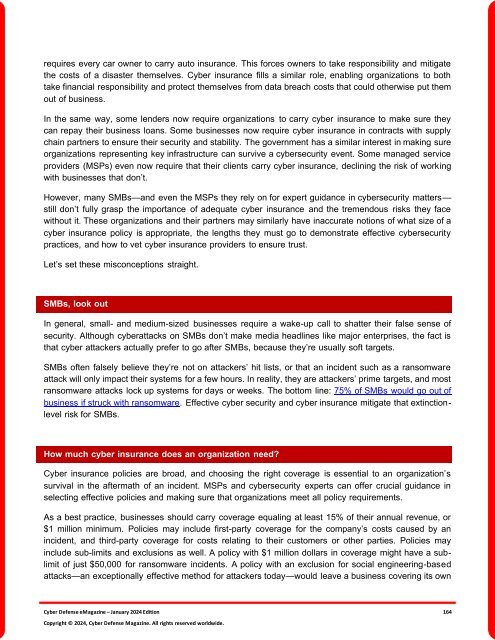The Cyber Defense eMagazine January Edition for 2024
Cyber Defense eMagazine January Edition for 2024 #CDM #CYBERDEFENSEMAG @CyberDefenseMag by @Miliefsky a world-renowned cyber security expert and the Publisher of Cyber Defense Magazine as part of the Cyber Defense Media Group as well as Yan Ross, Editor-in-Chief and many more writers, partners and supporters who make this an awesome publication! 201 page January Edition fully packed with some of our best content. Thank you all and to our readers! OSINT ROCKS! #CDM #CDMG #OSINT #CYBERSECURITY #INFOSEC #BEST #PRACTICES #TIPS #TECHNIQUES
Cyber Defense eMagazine January Edition for 2024 #CDM #CYBERDEFENSEMAG @CyberDefenseMag by @Miliefsky a world-renowned cyber security expert and the Publisher of Cyber Defense Magazine as part of the Cyber Defense Media Group as well as Yan Ross, Editor-in-Chief and many more writers, partners and supporters who make this an awesome publication! 201 page January Edition fully packed with some of our best content. Thank you all and to our readers! OSINT ROCKS! #CDM #CDMG #OSINT #CYBERSECURITY #INFOSEC #BEST #PRACTICES #TIPS #TECHNIQUES
You also want an ePaper? Increase the reach of your titles
YUMPU automatically turns print PDFs into web optimized ePapers that Google loves.
equires every car owner to carry auto insurance. This <strong>for</strong>ces owners to take responsibility and mitigate<br />
the costs of a disaster themselves. <strong>Cyber</strong> insurance fills a similar role, enabling organizations to both<br />
take financial responsibility and protect themselves from data breach costs that could otherwise put them<br />
out of business.<br />
In the same way, some lenders now require organizations to carry cyber insurance to make sure they<br />
can repay their business loans. Some businesses now require cyber insurance in contracts with supply<br />
chain partners to ensure their security and stability. <strong>The</strong> government has a similar interest in making sure<br />
organizations representing key infrastructure can survive a cybersecurity event. Some managed service<br />
providers (MSPs) even now require that their clients carry cyber insurance, declining the risk of working<br />
with businesses that don’t.<br />
However, many SMBs—and even the MSPs they rely on <strong>for</strong> expert guidance in cybersecurity matters—<br />
still don’t fully grasp the importance of adequate cyber insurance and the tremendous risks they face<br />
without it. <strong>The</strong>se organizations and their partners may similarly have inaccurate notions of what size of a<br />
cyber insurance policy is appropriate, the lengths they must go to demonstrate effective cybersecurity<br />
practices, and how to vet cyber insurance providers to ensure trust.<br />
Let’s set these misconceptions straight.<br />
SMBs, look out<br />
In general, small- and medium-sized businesses require a wake-up call to shatter their false sense of<br />
security. Although cyberattacks on SMBs don’t make media headlines like major enterprises, the fact is<br />
that cyber attackers actually prefer to go after SMBs, because they’re usually soft targets.<br />
SMBs often falsely believe they’re not on attackers’ hit lists, or that an incident such as a ransomware<br />
attack will only impact their systems <strong>for</strong> a few hours. In reality, they are attackers’ prime targets, and most<br />
ransomware attacks lock up systems <strong>for</strong> days or weeks. <strong>The</strong> bottom line: 75% of SMBs would go out of<br />
business if struck with ransomware. Effective cyber security and cyber insurance mitigate that extinctionlevel<br />
risk <strong>for</strong> SMBs.<br />
How much cyber insurance does an organization need?<br />
<strong>Cyber</strong> insurance policies are broad, and choosing the right coverage is essential to an organization’s<br />
survival in the aftermath of an incident. MSPs and cybersecurity experts can offer crucial guidance in<br />
selecting effective policies and making sure that organizations meet all policy requirements.<br />
As a best practice, businesses should carry coverage equaling at least 15% of their annual revenue, or<br />
$1 million minimum. Policies may include first-party coverage <strong>for</strong> the company’s costs caused by an<br />
incident, and third-party coverage <strong>for</strong> costs relating to their customers or other parties. Policies may<br />
include sub-limits and exclusions as well. A policy with $1 million dollars in coverage might have a sublimit<br />
of just $50,000 <strong>for</strong> ransomware incidents. A policy with an exclusion <strong>for</strong> social engineering-based<br />
attacks—an exceptionally effective method <strong>for</strong> attackers today—would leave a business covering its own<br />
<strong>Cyber</strong> <strong>Defense</strong> <strong>eMagazine</strong> – <strong>January</strong> <strong>2024</strong> <strong>Edition</strong> 164<br />
Copyright © <strong>2024</strong>, <strong>Cyber</strong> <strong>Defense</strong> Magazine. All rights reserved worldwide.

















